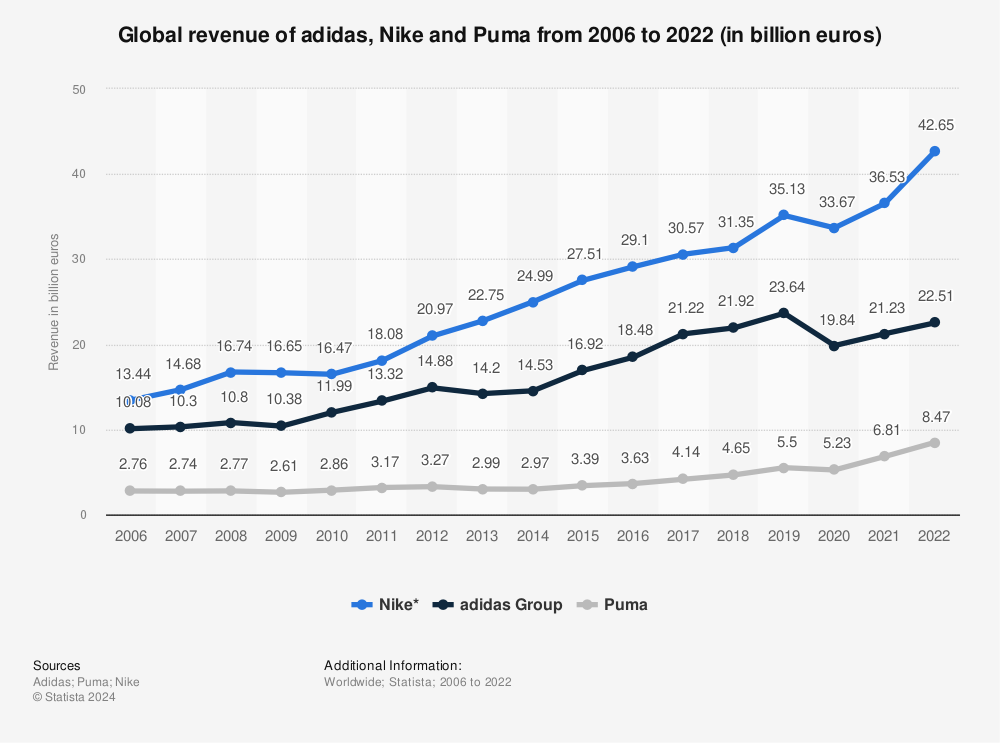 Overview of Content1,1 History
Overview of Content1,1 History1.2 Today
1.3 Product Segments
1.4 Puma’s Management Phases
1.5 Puma’s Strategies
1.7 SWOT Analysis
History
In 1924, Rudolf Dassler and
Adolf Dassler together founded a shoe company "Gebrüder Dassler
Schuhfabrik. This was only the company which manufactured sports shoes at that
time. They started the journey in their mother’s laundry. There was an irregularity
in supplies of electricity in the town. Sometimes they need to use a bicycle
and other stationery to run the machine. Later, they shifted in a different
building.
In 1936, they both drove to
Berlin and convinced Jesse Owen to use them in the summer Olympic. Wearing the
spikes, he won 4 gold medals and from there the business resonated. After
having different opinions and perceptions in running the business, both the
brothers got separated in 1948. Adolf started his own company named 'Adidas' in
which he used his nickname Adi and last three words Das from his surname
Dassler. Rudolf created a new firm and named it 'Ruda' using his own name.
Later, he changed the company name to 'Puma'.
Today
- Puma AG has
approximately 14000 plus employees and distributes its products in more
than 120 countries.
- CEO of Puma is
Bjorn Gulden from 2013.
- Puma is the main
manufacturer of cognoscente driving shoes and race suits.
- They are
the prime producer in Formula 1 and NASCAR especially.
- Puma has partnerships
with Ferrari and BMW.
Product
Segments
- Foot
wear: custom
made shoes, sports shoes and fancy shoes
- Apparel: T-shirts, boxers
and tracks
- Accessories: gloves,
helmet and water bottles
Puma’s Management Phases
Phase 1: Puma’s long term cooperate development plan begins with a streamlined focus to reconstruct the company and set-up a strong financial footing. Inscribe profit for the first time since its IPO in 1986. Introduced PUMA CELL technology, the first foam-free mid sole.
Phase 2: Puma’s long-term development plan begins with an aim to focus on the branding along with reposition via investment in marketing and product development. Puma and Jil Sandar joint venture launched footwear collection. Launched www.puma.com featuring regional e-commerce.
Phase 3: Phase III further focuses to inspect the potential of the brand by initiating desirable and profitable growth. Signed and official supplier of apparel and footwear FIA rally world championship. Launched 4some in Europe for cross-training events for women. Puma AG and Mild Seven Renault F1 signed a multi-year contract. Became the official supplier of racing shoes Michael Schumacher.
Phase 4: Phase 4 consists of long-term oriented business plan with
the mission to become the most desirable sport lifestyle company in the
world. Launched its own Golf Collection. Puma and Ducati, the world’s
premier motorcycle manufacturer and one of the top Moto GP teams announced a
new merger. Puma hired Hussein Chalayan, global designer, artist, and
film-maker as the creative director for Puma, responsible for designing,
creating and developing sports fashion collection of the brand.
Puma’s Strategies
Promotional Strategy: PUMA sponsors many national football teams. Provided sponsorship and created the clothing for many well-known professional football teams. It also sponsors football players. It also sponsors cricketers. [IPL teams]. PUMA supply equipment’s to four National Rugby league teams. Also sponsors cricketers. [IPL teams]. Supply sport's equipment to four National Rugby league teams.
Brand Strategy: Enter new niche market that represents PUMA. Design new “GREEN PRODUCT-LINE”. Create customization opportunities.
Goal Strategy: Bringing distinctive and a global outlook by blending influences of sports, lifestyle, and fashion. Maintaining vigilant watch over distribution channels. Appropriate guidance and firm attentiveness for a licensee.
Competitors
Nike
- One of top brands in the world.
- US based: administrative activities and design and product and innovation.
- Sub brands like "Tiger Woods" and "Michael Jordan".
Adidas
- Focus on core sports like soccer, tennis, athletics ans skiing.
- 6 times financial resources.
- Designing and marketing department located in France and Germany.

SWOT Analysis
Strength
- Experience in R and D
- Branding
- Management and international strategy
Opportunities
- Fitness hype
- Technology
- Acquisition and sponsorship
Weakness
- Missing sport segments
- Distribution system
- Comparable lower financial resources
Threats
- High competition
- Limitation of products
- Actual economic situation
Conclusion
Puma entered into fashion sector and became most favored brand. Also redefining the company structure leads to new image now being able to compete with world.
(An entrepreneur)
Comments
Post a Comment
If you have any doubt, let me know.